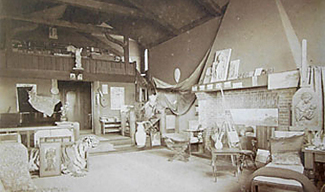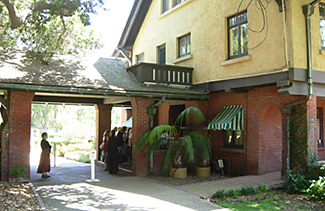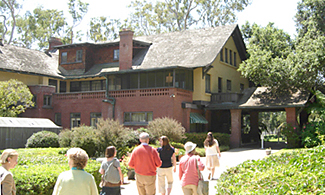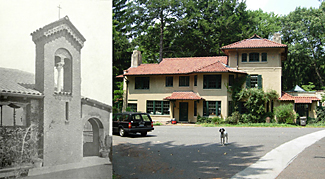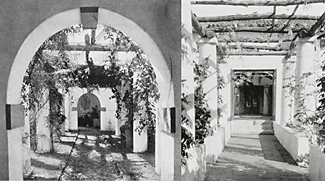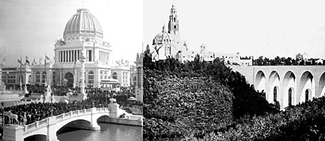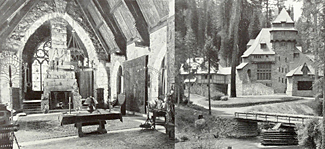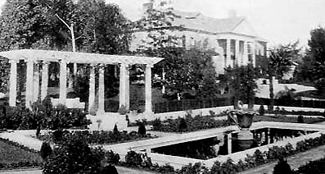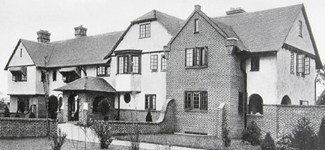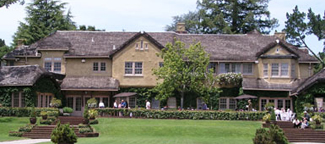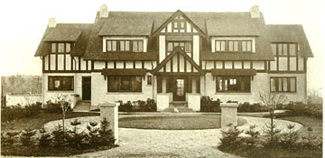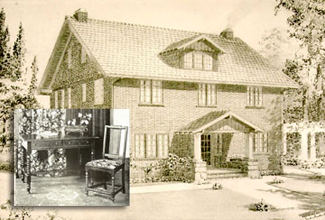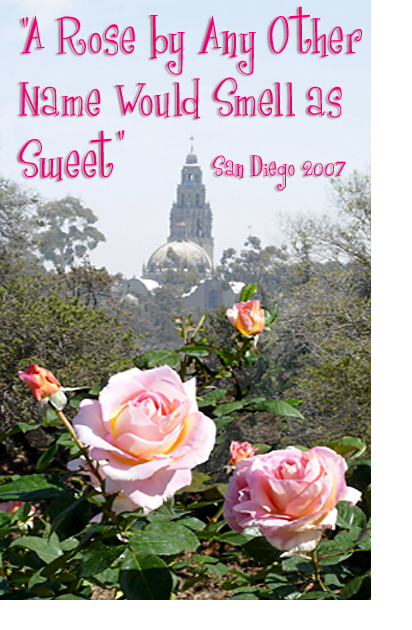 The best thing about San Diego is the climate. I left a sweltering June Philadelphia expecting worse heat in that “desert by the sea”; instead, it was a breezy seventy-six degrees for most mornings and nights while I was there. Locals regretted that conference attendees missed “June bloom”—this Easterner couldn’t imagine more blooms even if every bit of jewel-tone color was a reminder of the maharaja ransom in water needed to create the smallest patch of emerald green, ruby red, or sapphire blue. After battling black spot and green Japanese beetles in humid Pennsylvania, I had almost given up on roses. The roses in San Diego are testament to why they’re worth fighting for—there the blossoms seem to preen in the sun, their scent lying heavy on the dense, warm air. I know it’s not politically correct to like them because they’re not indigenous to Southern California, but conservationists and Ruskin be damned. I’m going to take a cue from Bertram Goodhue and think of Spain, where I saw ancient rose trees with trunks the size of an athlete’s leg.
The best thing about San Diego is the climate. I left a sweltering June Philadelphia expecting worse heat in that “desert by the sea”; instead, it was a breezy seventy-six degrees for most mornings and nights while I was there. Locals regretted that conference attendees missed “June bloom”—this Easterner couldn’t imagine more blooms even if every bit of jewel-tone color was a reminder of the maharaja ransom in water needed to create the smallest patch of emerald green, ruby red, or sapphire blue. After battling black spot and green Japanese beetles in humid Pennsylvania, I had almost given up on roses. The roses in San Diego are testament to why they’re worth fighting for—there the blossoms seem to preen in the sun, their scent lying heavy on the dense, warm air. I know it’s not politically correct to like them because they’re not indigenous to Southern California, but conservationists and Ruskin be damned. I’m going to take a cue from Bertram Goodhue and think of Spain, where I saw ancient rose trees with trunks the size of an athlete’s leg.
There is a grand rose garden in Balboa Park near the fantastic California Building, which Goodhue dreamt up for the “Magic Mission City.” Goodhue’s bridge and secular cathedral anchor one corner of the remaining 1915 Panama-California Exposition buildings where Lisa Koenigsberg’s ninth Arts and Crafts conference, Regionalism and Modernity: The Arts and Crafts Movement in San Diego and Environs began. (With a change in city name, the all-inclusive title might be maintained for any future conferences. Regionalism and Modernity: The Arts and Crafts Movement in Cincinnati and Environs for 2008?) Lisa and many other scholars interpret Arts and Crafts as a type of modernity perhaps because so many museum curators and art historians conflate Arts and Crafts progressive social reform with progressive design.
As his conference opener showed, Robert Judson Clark has been able to move on beyond his seminal efforts to define American Arts and Crafts. Most of the rest of the speakers used his 1972 parameters as the foundation for their talks—perhaps to honor his presence at the conference, more likely because it is easier and faster than thinking for one’s self. Cheryl Robertson extolled the virtues of “reinforcement,” “recapitulation,” and “reiteration.” If the audience had been a callow class of freshman college students, perhaps, but the few there who were not parts of the program were either consorts of the program’s parts or rich, longtime lovers of Arts and Crafts with nothing better to do than spend a week in the dark with the object of their affection. To pound them with her three Rs was condescending at best.
For some reason, scholars other than Clark are still unwilling to let Arts and Crafts be whatever it was wherever it was. They seem to need to validate the movement with trumped-up proof that it was not only what its practitioners said it was (honest, sincere, democratic, indigenous, and beautiful for meeting the preceding qualifications) but also better because, with hindsight, it can be seen to be distinctively regional, new, original, progressive, modern, and innovative. In San Diego, most of the “proof” of regionalism presented convinced me that Eastern ideas got to San Diego (and environs) and merely donned sequined sombreros. We were shown images of A. Page Brown and A.C. Schweinfurth West Coast buildings that would be indistinguishable from east-of-the-Mississippi buildings by Stanford White, Frank Lloyd Wright, or Will Price were it not for the imported palms.
 |
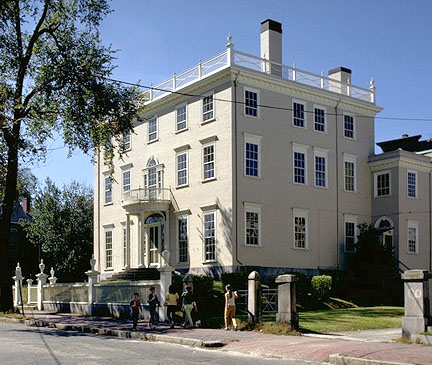 |
 |
|
What can we make of A. Page Brown’s design for the Richard E. Queen house, which was built in San Francisco in 1895? It is a hybrid (right) based on several houses built in New England almost a century earlier. The corner pilasters are very like those on Salem’s Pierce-Nichols house, which has a façade (left) designed by Samuel McIntire. The Palladian window placed above a semicircular portico was standard on grand Federal mansions like the one (center) Hugh McClellan had built in Portland, Maine. Many scholars lump the Colonial Revival into the American Arts and Crafts movement, but, since houses like Queen’s and the Greenes’ Barker House are not anomalies in the West, we might question our views of how committed artists were to any particular set of rules about regionalism.
|
||
For me, Clark’s most striking image was a pre-restoration photograph of the Sonoma Mission—it had a stumpy Greek Revival steeple that made it look just like the early nineteenth-century wooden churchs and town halls strewn around New England.
 |
 |
|
A tour on New England byways or even a more committed Internet search would have turned up a building with the same round headed openings as those on the Sonoma Mission.
|
|
San Diego’s most precious art icon is Irving Gill, who was so much discussed during the conference that I couldn’t bear to think of or speak his name for several days after I returned home. Gill provides a fine example of the kind of Arts and Crafts navel-gazing that happens at these conferences. His international-modern, machine-for-living ideas were pigeonholed as Arts and Crafts simple living. For me, Frank Lloyd Wright became “modern” when he turned the fake Tudor half-timbering he used on the Nathan Moore House into the horizontal lathe strips he stuck onto the sides of his Prairie houses. Similarly, Gill designs didn’t become “modern” until he transformed the soft brown edges of pueblo adobe into the harder, whiter edges of Bauhaus.
 |
His much-touted use of light and central cleaning systems had been in use for more than a decade before in houses like the monster Richardsonian stone pile that is the 1888 James Hill House in St. Paul, Minnesota,which had the same conveniences and many more. I suppose Hill House was also modern in its day, but not in a way Arts and Crafts devotees understand and admire.
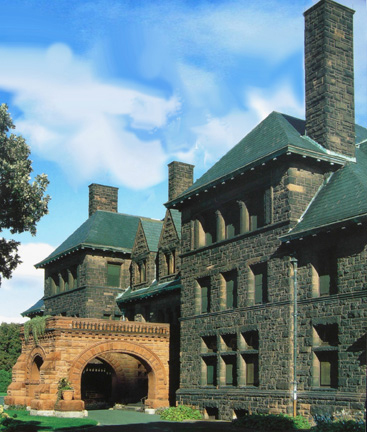
|
T The first field trip was to the George Marston House, designed at least in part by Gill. It now belongs to the San Diego Historical Society, and their interpretation of its significance is a scary example of how dangerous a little knowledge can be. The exterior of the building was evidently conceived by William Hebbard as a large, prosaic Tudor-style house that would have caused no notice at all had it been built anywhere on the eastern seaboard. Gill came along and stripped off the fake half-timbering, which didn’t make the design any more notable or Arts and Crafts. I don’t know if the San Diego Historical Society has actual documentation of Gill’s contribution to the interior design, but they think they have it all figured out. Our guide, who uses the present tense for all the historical anecdotes she shares, tells us the living room fireplace and the della Robbia cast above it are the only remnants of Hebbard’s Tudor scheme. We aren’t allowed to take photographs so I can’t show you the simple red-brick fireplace with an arched opening that is workaday Arts and Crafts anywhere from Chicago to Boston’s North Shore. We are told that the singing children in the plaster cast represent the five Marston kids, which is possibly true, but does not take into consideration how much the pert bums in that particular frieze are appreciated by Arts and Craftsmen all over the world. The house is furnished with mass-produced American Arts and Crafts furnishings from factories like Limbert and the Stickleys, which our guide tells us is what the Marstons own since they retail such stuff in their department store—sure, and Vera Wang wears her wedding dresses around her New York City apartment. We are told that the inlaid Stickley desk is the only piece Harvey Ellis was allowed to sign. If so, that desk is unique and worth so much more than its high 1980s purchase price of $20,000 that its sale can fund a new study of how the Marstons really live in the house. Moving into the very dark hall, we are told the open back door is an example of how Gill brings light through his houses. Is it that or is the house a fine example of East Coast transplant Charles Keeler’s recommendation in The Simple Home about the desirability of having natural light transition from unobstructed sunlight to light filtered through vines on a pergola to shade from wide eaves or porch roofs to the cool darkness of an interior? The dining room is done up in a dusky 1980s blue and has cheap stainless steel flatware placed neatly around the fake lilac centerpiece on the L. & J.G. Stickley library table. Just what are we learning—that the Marstons use knives and forks? |
| The upstairs hall exhibits what we are told is another Gill innovation: He puts an interior window in a linen closet just like those in the Hill House. Okay, the general public needn’t be bored by such arcane details so let’s move on to the nursery, which isn’t used as a nursery when the Marstons live here because their children are grown. Never mind! We must skip the rest of the house and rush outside for some three Rs. A new guide is about to tell us what we heard before we entered the house earlier—now we have 4 Rs: redundant reiteration, reinforced by the recapitulation of questionable facts. |
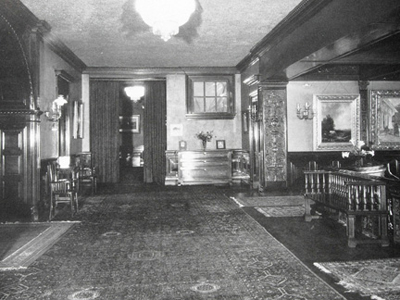 |
|
The window above the chest of drawers in the center of the photograph opens into a linen closet on the second floor of the 1888 Hill House in St. Paul, Minnesota.
|
Robert Winter was not well enough to present his forty-minute talk about Goodhue and the fair scheduled for the first day and Phoebe Kropp copped out on her forty-five-minute talk, but all that added time didn’t keep the schedule from lagging as it has year after year. Opportunities for questions and answers were reinstated as time permitted. It usually didn’t permit, so I had to gamble that I’d be able to sound off after a lecture whose very title had me in a tizzy. I use the word tizzy because I know nothing in the conference or about the Arts and Crafts movement is worth getting seriously riled up about. The movement was and remains fatally out of this world. I held my tongue while we were invited to:
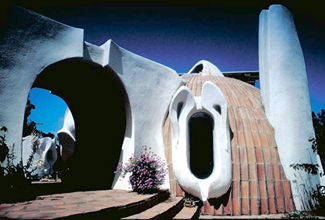 Hubbell and Hubbell House.
1
|
Think of James Hubbell’s architecture as an extension of Arts and Crafts simplicity. Believe that commitment is the core of the Arts and Crafts movement. Lisa Koenigsberg 1 1 See how Italian precedent combined with Spanish to make a Mediterranean style that was national rather than a mission style that started in the Southwest. Robert Judson Clark 1 1 1 Weigh whether Gill’s appreciation of the “simplicity of [his] Quaker forbearers” amounted to modernism or historicism. Thomas Hines C Contemplate what “absolute sincerity,” “loving interest in work,” or “connection to nature” might be found in the Grand Rapids rocking chair in the interior of El Museo, a rock confection where the intensely East-Coast-establishment-educated Charles Lummis mummified artfacts from Native American cultures for the delectation of white Anglo-Saxon Protestants. Cheryl Robertson Delight in the “mimetic” (used by Thomas Hines and one of those words one wants to remember to mimic) name for the 1915 exposition: “Magic Mission City”—earlier and further east, the 1893 World’s Columbian Exposition in Chicago had been called “The Magic City.” David Streatfield 1 Realize the California Building is an eastern or Beaux Arts interpretation of high-style Spanish baroque architecture and not an interpretation of humble California missions. 1 See how you can find similarities in the work of Goodhue and Frank Lloyd Wright if you choose your examples carefully and without regard to chronology. 1 1 View Keene-eyed Mexican kids who pounded mountains of mud into acres of handmade bricks as appreciating the “joy and integrity of social labor.” 1 See the buildings of the Panama-California Exposition as examples of “unadorned use of indigenous materials.” Matthew Bokovoy 1 Use Borite for termites! Paul Johnson Wonder why the virtuoso, grossly realistic hand-raised oranges and blossoms on a Tiffany silver presentation tankard are not examples of Ruskin’s “close study of nature.” W. Scott Braznell Q Question why an orchid painted on a pot by Valentian is an example of Ruskin’s “close study of nature” and a hand-painted plant on a Royal Copenhagen Flora Danica plate is not. John Digesare Contemplate how “depictions of nature views reflect culture.” Contemplate how “depictions of missions reflect high moral standards.” Contemplate how Hearst’s castle might be “intrinsically welcoming” and a “model for everyday life.” Joseph Taylor |
Correcting the Record: The American Arts and Crafts Traveled West to East, Not Vice Versa was excused by its author Leslie Freudenheim as being a “work in progress.” In fact it was less than half-baked. Many of the lecturers were august, published authors who had the grace not to promote their own books. Freudenheim was as shameless in flogging her frothy lifestyle books as she was naively delighted in fancying how her west-to-east theory would provoke. Provoke she did, but not as I suspect she intended—I was provoked, not by her theory, but her airy disregard for earlier scholarship on the subject and her faulty, obviously cursory research. She used secondary, if not tertiary, sources. She began with a preemptory new name for the American Arts and Crafts movement by pronouncing that it could “aptly” be rechristened the “Craftsman movement.” How presidential to rewrite history to make it fit your premise. To be fair, Freudenheim’s view of the movement is limited to what she can see through the lens of Gustav Stickley’s writings as they appear in anthologies and in reproductions of his Craftsman magazine—had she stuck with that narrow field of vision, she might have been able to demonstrate how some Western interpretations of Eastern ideas ended up as a part of Stickley’s populist, commercial spin on the movement, thereby gaining a national audience. She wouldn’t be correcting any record, but at least she would be correct.
Freudenheim cut the Aesthetic movement away from the Arts and Crafts movement by showing a slide of a late nineteenth-century room with few Aesthetic movement pretensions and discussing why it was not Arts and Crafts. I’m guessing she would as confidently use a dull scalpel to separate conjoined twins who share a single heart. Accepting her notion that there was a clear distinction between the Aesthetic movement’s cult of beauty and the Arts and Crafts movement’s cult of the simple life requires rejecting much about William Morris, but that’s okay because Morris was British—the influence of his ideas stopped on the eastern shore of the Mississippi, where a 2,320-mile-long fence had been built to keep ideas from crossing. The American or “Craftsman” movement sprang up (perforce a virgin birth!) in the fertile, if necessarily sterile, soil of California with the completion of Joseph Worcester’s 1876 Piedmont camp and his later Russian Hill House, which formed the “the basis for the American simple home.” She claimed such California simple homes were “affordable” and “rejected costly goods.”
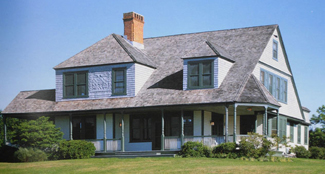 One of several relatively simple houses McKim, Mead & White designed for Montauk Point on Long Island, New York in 1882.
|
S
She proved her theory by comparing West Coast domestic structures with Daniel Burnham’s skyscrapers and Stanford White’s Gilded Age mansions. Most people attending the conference knew how “affordable” the “goods” used in the Gambles’ “simple home” were. They also knew about the many simple (simpler?) homes White built years before Worcester and his buddies put up their architectural quotes on Russian Hill. But I am concerned for readers who might find her theory in the context of the Borders or Barnes & Noble “Art and Architecture” section. Freudenheim conveniently ignored Maybeck’s Germanic Berkeley houses with their steep roofs more suited to fending off alpine snow than to absorbing California sunshine. This group of relatively large, shingle-style structures, which the designer himself called “Gothic,” included the “simple home” of the author of The Simple Home. She sneaked past Maybeck’s Palace of Fine Arts but made a quick visit to Wyntoon—now that’s some simple life! On her way toward equating the California bungalow with American Arts and Crafts architecture, she stopped by Greene and Greene houses that many before her have called “the ultimate bungalows.” Although not their only style, these extreme structures represented the Greenes’ most outstanding style and were widely published in magazines like House Beautiful, but they did not have much influence on the style of American domestic architecture in general. Truth to tell, magazines may have diminished the impact of the Greenes’ originality by publishing houses like their 1902 “Maryland Colonial type” built in Pasadena for George Barker. The style of the Gamble House and the other “ultimate bungalows” was a dead end at least for the Greenes, who often resorted to East Coast styles in their later years. The 1926 Fleishhacker House (particularly the garden façade) apes designs by Pennsylvania architect Wilson Eyre and its roof imitates British thatch by wrapping the eaves with shingles. |
Using Worcester’s 1876 camp as the starting point for the simple life’s west-to-east journey would be dramatic if it could be supported with facts. But the author’s charming insouciance couldn’t get her trip started any further west than the Adirondacks. Joel Headley published the first edition of The Adirondack: or, Life in the Woods in 1849. He wasn’t writing just about hunting or logging, but also about the health benefits of mountain air and the soul-restoring power of mountain views where the “thronged city” and “strifes of men” were nowhere to be seen—if this is not the mountain-high version of Worcester’s simple life on the down low of the Piedmont, Freudenheim (and Robertson, who blazed the west-to-east trail in 1993) have yet to adequately explain why. Closer to the “thronged city” of Philadelphia, Frank Furness built a retreat into his house, which he started in 1873—it had all the accoutrements of the romantic, rustic, natural, native simple life that Freudenheim claims started in California.
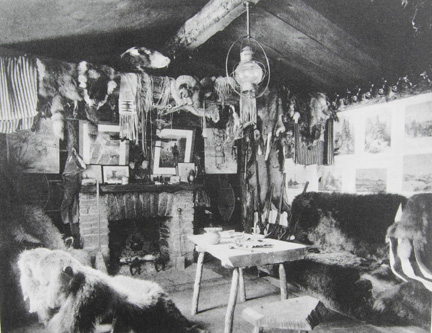
Look, Dick! Look, Jane! See Frank’s Indian stuff.
“Oh, Dick, see Spot jump on Frank’s buffalo robes,” said Jane.
“I see the rustic beams,” said Dick. “Guess where Frank’s room is. Guess, guess!”
Freudenheim went beyond asserting Worcester invented the simple lifestyle to claim that his camp was the first identifiable architectural expression of her “Craftsman movement.” The only known image of the camp is in a small painting, which shows one side of the building in the middle ground of a vast sunset panorama. Still, the few small brushstrokes the artist used to render the house provide enough information to determine that the roof at least followed the shape of bungalows built in British-Colonial India, where the form is supposed to have originated. Similar bungalows were built in the eastern United States, particularly in the South—many postdate Worcester’s, but I doubt any were inspired by it.
There is an important link from Worcester’s camp to the generic “Craftsman bungalow” that was ignored by Freudenheim and everyone else at the conference, even though it still exists almost within sight of the museum where the lectures were held. The Brockton Villa (after Brockton, Massachusetts) was built in 1894 for Dr. Joseph Rhodes on the edge of the steep hillside that descends to the rock cliffs of La Jolla Cove. It is now somewhat buried within the recent porch additions of a restaurant where one can still see the original interior structure under layers of shiny white paint and the wondrous abalone-shell-encrusted fireplace. The Red Roost and The Red Rest stand just down Coast Boulevard. These 1894 bungalows are on the National Register, but if nothing is done they will soon be gone from La Jolla. The owner of the high-rise hotel next door wants the very valuable land for the income its views of the Pacific could generate, so the cottages have been swaddled in black plastic and flake board and left to disintegrate. The Save Our Heritage Organisation facilitated many events for the conference. The Red Roost and Red Rest are #12 on the organization’s 2007 “Most Endangered” list. It would be grand if the conference took an active rather than passive role in the cities it visits. What might the effect have been if the attendees picketed the very visible site while waiting for the little shuttle bus to take them seven at a time to the Gill-designed Bailey House? Would local newspapers have taken photos? The conference visited #2 on the list, the tightly guarded Salk Institute. Would they have been arrested if, after studying Philadelphian Louis Kahn’s work, they marched to the bus with an unfurled plaza-long banner protesting a master plan, which will seriously compromise the globally acclaimed design?
 |
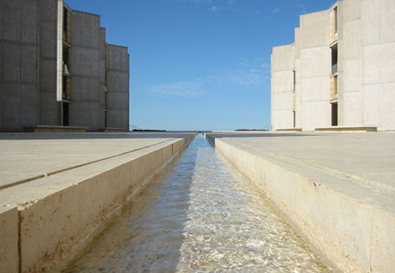 |
|
The Red Roost and the Red Rest, 2007, La Jolla, California.
|
The plaza at the Salk Institute, 2007.
|
 The chair on the left bears Joseph McHugh’s “Mission Furniture” mark, but, as the earlier French Art Nouveau chair on the right makes obvious, its inspiration was from far across the Atlantic and not from missions near the Pacific.
|
Ms. Freudenheim got hopelessly lost among the differences between California Mission Revival architecture and mass-produced mission-style furniture because she used Easterner Joseph McHugh’s advertising gimmick as a landmark. A huckster on par with Elbert Hubbard, McHugh figured few people would realize the chair that, according to his own account, inspired his “Mission Furniture” line had nothing to do with California missions. He swiped the design from chairs used by Worcester in his Italianate, Swedenborgian church. Those church chairs were made of maple with a natural finish; they had little to do with the faked “honest construction” McHugh used on artificially colored oak furniture made to satisfy any and every modern need from hat racks to porch swings to swivel office chairs and shown in advertising with toga-clad ancient Romans. McHugh’s story is hilariously incredible, but this woman fell for it and built her theory on it. She posited that Gustav Stickley produced mission-style furniture even though he railed against the term’s associations to Hispanic culture. She implied mission-style California bungalows dominated The Craftsman magazine after Stickley saw them during a visit to California and that House Beautiful magazine promoted the Arts and Crafts style. She used a detail of a Craftsman cover as it appeared in reproduction above an unrelated drawing of an interior on the cover of a modern anthology to illustrate her point. Had she bothered to do even the most basic research by surveying the full run of The Craftsman or House Beautiful, she would have seen that no single style prevails in either periodical. Even if Stickley had endorsed the California bungalow style over all others, the influence of his magazine would not have been (and, as it happened, was not) enough to send a style tsunami from the Pacific to the Atlantic. |
In the end, I did get to ask my question, which was more a statement suggesting that the ideas she thought were specific to the West were at least current at the same time in the East. Not until the Standard Time Law was enacted in 1918 would California get the worm, after that the West Coast would always be the early bird. She responded appropriately with reiteration, redundancy, reinforcement, and recapitulation when she reminded me that she had said her theory was a work in progress at the start of her talk. I have to admit she unwittingly added at least a couple more Rs (wrong and revelation) when she showed a van Gogh ink drawing of a French village of thatch-roofed cottages. Earlier in the conference Bruce Smith said Japan was the source of the Greenes’ use of exposed rafter tails, but, he said, the brothers were the first to extend rafter tails beyond the roofline. Au contraire, there in southern France were revealed rustic rafters sticking way out beyond the thatch!

Lisa does not publish the conference lectures, so their useful life pretty much ends as soon as they are presented. Therefore I found myself valuing the quality of presentation over content. Some lecturers couldn’t be bothered with learning newer presentation methods, so they tested audience endurance with the same faded, out-of-focus, out-of order, upside down, jammed slides they’ve been struggling with for the past thirty years. Others made up for having nothing to say with well-designed, powerful graphics and large, crisp, colorful photographs presented in smooth-running computer programs. Best of all were those like Bruce Smith and Heidi Nasstrom Evans, who were in full control of their medium and their message so they were able not just to inform, but also to entertain—I appreciated their evident respect for their audience! Bruce’s presentation about how Japan was envisioned in Southern California woke me up and delighted me with the sprightly pace and humorous tone of a Gilbert and Sullivan operetta. The conference lectures ended with Heidi’s short, sweet, and poetic description of the time Jane and Ralph Radcliffe-Whitehead spent in California, which was carried by the exquisite, melancholy imagery she chose.
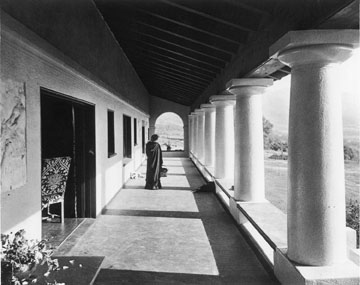 |
|
At first glance one might assume the colonnade the Whiteheads had built on their Santa Barbara home was designed in the mission style. Indeed there are photographs of a mission with an almost identical structure in the family’s albums. But Jane and Ralph named their home Arcady and Jane, who here walks away from the photographer her husband, called this space with casts of classical sculptures set into the wall a “stoa” so we know she was thinking of romantic Mediterranean places like Horace’s villa in the Sabine Woods.
|
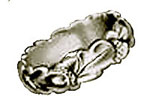
Passionate commitment combined with subjective, insufficient information and a narrow perspective leads to wars of proving points. On the other hand, creative thinking needn’t be combative because it has nothing to prove—it can combine credible references with objective insight to explain the big picture. The Arts and Crafts movement came to the United States at a time when the flow of ideas from one coast to the other ran fast and easy both ways. But, certainly, regional characteristics in our arts and minds existed before Eastern Asians came west and before Western Europeans came east and continue to exist. The way pre-Columbian artisans made and used things was probably dictated in a large part by religion. So, too, the Arts and Crafts movement may be seen as a religion that attempted to prescribe how things ought to be made as well as how they ought to be used. There’s not much difference between casting a bat into a gold bell amulet and chasing an oak leaf onto a silver wedding ring. For me, the bell or the ring is the big picture. Who, what, when, why, and how are useful focusing mechanisms. Characterizations like modern, progressive, prototypical, or mimetic seem like framing devices, which can enhance appreciation unless they are the only meaning an object has. If the first cubist painting could be identified and it turned out to be an ugly, poorly executed portrait painted on black velvet by Leonardo da Vinci in 1869 when the artist was four years old, it would end up at MoMA or the Met, but not at my museum!


